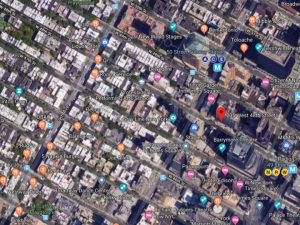Macro and Micro Moments
Time management is not just a matter of productivity, success, and efficiency. It can also be a question of control, ozio creativo, and much more. This was my starting point when it comes to time management: to find out what we’re really trying to achieve through managing our time.
I then found myself facing a period of time—a year, for example—and learning that it could be useful to break it down into macro and micro moments. Let me explain what that means and how I get there.
How can we look at time?
What is the first answer that comes to your mind? Are there different ways to look at time?
Wherever you are—now, at the exact moment when you are reading these lines—try to stop what you are doing and start watching what is happening around you. A thousand scenarios are opened. From the solitude and peace of a corner all for you, to the confusion of a crowded place in which you’ve stolen a few minutes, stop just for a few moments!
This is how much it takes to remind us that when we talk about time there is always a before. We can look back and there is an after. We can also look forward.
There is only one difference between before and after. But it is a big difference that can change your entire perspective.
When we say “after” we unfortunately can’t use the adverb “always.” It is the lack of “always” that provides time with its value.
Looking back to look forward is one of the ways I like to think about time.
Looking forward
Looking forward means having great powers. Great responsibilities arise from great powers.
We have a lot of power in our hands, a power that carries with it a great responsibility. We should live our lives at our best, and we should try to be happy. Yes, we should aim to be happy. Happiness is a word with deep connotations; it is extremely personal and totally different for each of us.
What does happiness have to do with time management? Think of the words of Laura Vanderkam:
“Time is highly elastic. We cannot make more time, but time will stretch to accommodate what we choose to put into it.”
We should use our time to be happy. There it is, a very simple sentence that brings with it a deep reflection. I am going to park the concept of happiness for the moment. It’s too big and deserves much more than a few lines.
Let’s just say that happiness is our North Star. Now let’s go back to looking at time.
Short, medium, and long term
The way we look at time, dividing it into short, medium, and long term has an economic-financial matrix.
“One of the most important things to choose when investing is the duration of the investment. Different time horizons mean different investment strategies, different approaches, and different techniques. The time allocations used in economics and finance are short, medium, and long term. The definitions of short, medium, and long term … however, are not firm, because the specific duration may change over time, due to changes in the economic structure or phases of the financial markets. “
Despite the economic nature of the sentence, I found in it at least three fundamental messages that I believe should be kept in mind when thinking about time management:
1) The distinction between short, medium, and long term.
I have at least a couple of comments about this. The world is changing at such a speed and scale that the meaning of these three words is constantly being challenged. What does short term mean in a digital world? Perhaps only the duration of my thirty-year mortgage can still legitimately be called “long-term.”
What does short, medium, or long term mean in a city like New York, in a small town in Louisiana, in Milan, or in a village like Moie in my beloved Marche in Italy? What does short, medium, or long term mean for the logistics department of a company or for the marketing department?
Short, medium, and long term can have very different meanings depending on the context. This is quite obvious, but it is also important to remember.
2) The concept of flexibility.
Flexibility is the ability to manage change. Being flexible is crucial, since there could be changes in various contexts. We know that sometimes we can find ourselves rushing into something we did not expect yet or, on the other end of the spectrum, sometimes we can find ourselves waiting much longer than expected. We also know that we can face unexpected situations that require changing our plans. Think about how relevant this concept of flexibility is to managing time.
3) The idea that different time horizons require different strategies and tactics.
Short, medium, and long term represent an almost traditional way to approach time. Long-term plans are usually ambitious and aspirational. Medium- and short-term plans are more attainable and most of the time less sexy, but they are important if we want to achieve something in the long run. In the past I used this distinction often, even though I’ve found that sometimes in not actionable enough. This is one of the reasons I started to embrace the concept of macro and micro applied to time management.
Macro e Micro
Open Google Maps (or imagine yourself in front of Google Maps.)
By clicking on the + button—by zooming out—you can get something very similar to what you can see here.

By clicking on the – button—by zooming in—you get something very different.

With the zoom in we have access to a world of information that includes very specific details. With the zoom out this world doesn’t disappear, we simply have another perspective.
I like to look at time by borrowing the Google Maps logic.
I like starting from a complete zoom out and then gradually I like to zoom in. I like to think of having the possibility when it is necessary to change perspective and move from macro to micro and vice versa.
Macro and Micro Moments
What do macro and micro moments mean?
Try to keep the idea of the zoom out and zoom in and add the time dimension. You will get a different perspective from which to look at time and its management.
As for short, medium, and long term, the meaning of the terms macro and micro moments can be extremely personal and therefore very relative.
Macro Moments
Personally, I tend to put in this category everything that traditionally can be considered short / medium / long term.
Wait, all the three categories together?
Yes, all together.
It is a question of perspective. Forget the short, medium, and long term. Zoom out. From that perspective, now try to look down and you will see:
a set of years
a set of months
a set of weeks
a set of days
and then again … Monday, the beginning of the month, mornings, afternoons, evenings, nights …
And of course you can transform all of them into a set of milestones, important events, moments, commitments, projects, and so on.
You will find a single common denominator: micro moments.
Micro moments
With a zoom in we are not throwing away any of the macro categories we just saw, we are only changing the perspective. It is about breaking down years, months, weeks, days, and every other macro view into small—micro—moments made of seconds, or at most a few minutes.
The relationship between macro and micro is crucial. Every accomplishment at the macro level is possible thanks to what we are doing at the micro level—what we are doing in a matter of seconds and minutes.
By being focused on the micro level, we are able to be “in the zone,” fully immersed in a feeling of energized focus, full involvement, and enjoyment. We can expand our mindfulness and concentrate on the now. It is a combination of several micro moments that will add up to the macro moments, milestones, events, commitments, projects, and so on.
The idea is based on the concept of “simplifying” supported by experts in behavioral changes. Simplifying is another notion that we will park for the moment and come back to later.
There are many ways to look at time.
I don’t know about you, but I often find myself looking at my life, at the New Year, the new month, or just a new week. I do this by looking back and trying to take into account all the knowledge and experience of the past; I do it by looking forward and by trying to give value to what awaits me.
And here I am. I do organize, plan, schedule, and reschedule. I like to move from the macro to the micro view and then to go back from the micro to the macro view in a constant process of growth.
How can we look at time management?
In order to best organize, plan, and manage our time, it could be useful to look at it in terms of macro and micro moments. Think about it and start identifying your macro and micro moments. We will organize, plan, and manage them shortly.
Stay tuned and have a good week!
Photo by Azamat Zhanisov on Unsplash






A great way of ensuring that we use our uniqueness to our advantage and sometimes that means having to get out of our comfort zones.
Thank you Lyn!